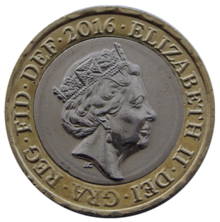Two pounds (British coin)
| United Kingdom | |
| Value | 2 pounds sterling |
|---|---|
| Mass | 12 g |
| Diameter | 28.4 mm |
| Thickness | 2.5 mm |
| Edge | Milled, with incuse lettering |
| Composition | Outer ring: Nickel-brass (76% Cu, 20% Zn and 4% Ni) Centre: Cupro-nickel (75% Cu , 25% Ni) |
| Years of minting | 1997–present |
| Obverse | |
 |
|
| Design | Queen Elizabeth II |
| Designer | Jody Clark |
| Design date | 2015 |
| Reverse | |
 |
|
| Design | Britannia |
| Designer | Antony Dufort |
| Design date | 2015 |
The British two pound (£2) coin is a denomination of the pound sterling. Its obverse has featured the profile of Queen Elizabeth II since the coin’s introduction. Three different portraits of the Queen have been used, with the latest design by Jody Clark being introduced in 2015. The reverse features an abstract design symbolising the history of technological achievement. A new reverse design featuring Britannia began to enter circulation during 2015.
The coin was introduced on 15 June 1998 (coins minted 1997) after a review of the United Kingdom's coinage decided that a general-circulation £2 coin was needed. The new bi-metallic design replaced a series of commemorative, uni-metallic coins which were issued between 1986 and 1996 to celebrate special occasions. Although legal tender, these coins have never been common in everyday circulation.
As of March 2014 there were an estimated 417 million £2 coins in circulation with an estimated face value of £831.756 million.
The original reverse of the coin, designed by Bruce Rushin, is an abstract design symbolising the history of technological achievement, accompanied by the words TWO POUNDS above, and the year of minting below. This was the first bi-metallic coin to be produced for circulation in Britain since the tin farthing with a copper plug produced in 1692, and is the highest denomination coin in common circulation in the UK. The coin consists of an outer yellow metal nickel-brass ring made from 76% copper, 20% zinc, and 4% nickel, and an inner steel-coloured cupro-nickel disc made from 75% copper, 25% nickel. The coin weighs 12 grams and is 28.4 millimetres in diameter.
The design itself was first tried out in 1994 when the Royal Mint produced a short run of demonstration pieces to the new bi-metal standard. These pieces were not for circulation and were simply intended to test the manufacturing process. The coin was technically similar to the version which eventually entered circulation with the Maklouf effigy of Queen Elizabeth II on the obverse and the image of a sailing ship similar to that previously used on the reverse of the pre-decimal halfpenny piece. The inscription on the reverse read ROYAL MINT TRIAL 1994 with an edge inscription based on the one pound coin which read DECUS ET TUTAMEN ANNO REGNI XLVI, meaning "An ornament and a safeguard – in the 46th year of her reign". The 1994 pieces were never legal tender but were eventually released for sale as part of a presentation set in 1998. At the same time in 1994 the Royal Mint produced a mono-metallic trial two-pound coin, with the same ship reverse and inscription, but otherwise similar to the earlier commemorative coins. These were never issued in presentation sets, and so are much scarcer than the bi-metallic version.
...
Wikipedia
